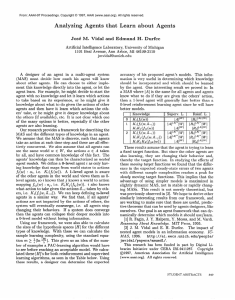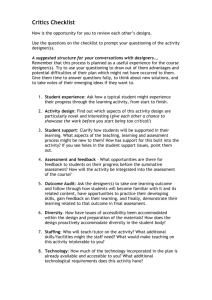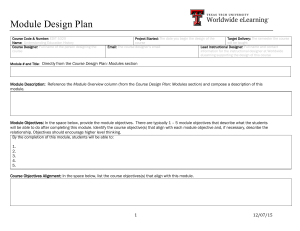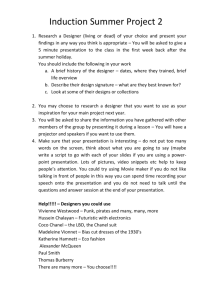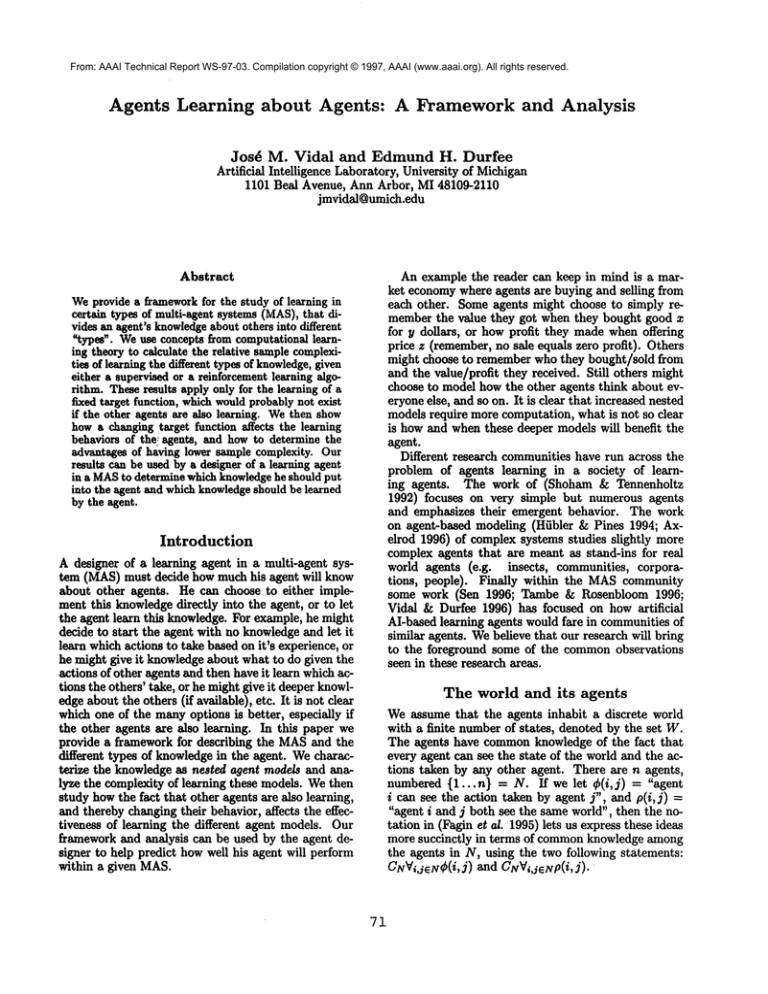
From: AAAI Technical Report WS-97-03. Compilation copyright © 1997, AAAI (www.aaai.org). All rights reserved.
Agents Learning
about Agents:
A Framework and Analysis
Jos~ M. Vidal
and Edmund H. Durfee
Artificial Intelligence Laboratory, University of Michigan
1101 Beal Avenue, Ann Arbor, MI 48109-2110
jmvidal@umich.edu
Abstract
An example the reader can keep in mind is a market economy where agents are buying and selling from
each other. Some agents might choose to simply remember the value they got when they bought good z
for y dollars, or how profit they made when offering
price z (remember, no sale equals zero profit). Others
might choose to remember who they bought/sold from
and the value/profit they received. Still others might
choose to model how the other agents think about everyone else, and so on. It is clear that increased nested
models require more computation, what is not so clear
is how and when these deeper models will benefit the
agent.
Different research communities have run across the
problem of agents learning in a society of learning agents. The work of (Shoham & Tennenholtz
1992) focuses on very simple but numerous agents
and emphasizes their emergent behavior. The work
on agent-based modeling (H/ibler & Pines 1994; Axelrod 1996) of complex systems studies slightly more
complex agents that are meant as stand-ins for real
world agents (e.g. insects, communities, corporations, people). Finally within the MAScommunity
some work (Sen 1996; Tambe & Rosenbloom 1996;
Vidal & Duffee 1996) has focused on how artificial
ALbased learning agents would fare in communities of
similar agents. Webelieve that our research will bring
to the foreground some of the commonobservations
seen in these research areas.
Weprovide a frameworkfor the study of learning in
certain types of multi-agent systems (MAS),that divides an agent’s knowledgeabout others into different
utypes’. Weuse concepts from computational learning theoryto calculate the relative samplecomplexities of learningthe different types of knowledge,
given
either a supervisedor a reinforcementlearning algorithm. Theseresults apply only for the learning of a
fixed target function, which wouldprobably not exist
if the other agents are also learning. Wethen show
howa changing target function affects the learning
behaviors of the/agents, and howto determine the
advantages of having lower sample complexity. Our
results can be used by a designer of a learning agent
in a MAS
to determine which knowledgehe should put
into the agent and which knowledgeshould be learned
by the agent.
Introduction
A designer of a learning agent in a multi-agent system (MAS) must decide how much his agent will know
about other agents. He can choose to either implement this knowledgedirectly into the agent, or to let
the agent learn this knowledge. For example, he might
decide to start the agent with no knowledgeand let it
learn which actions to take based on it’s experience, or
he might give it knowledge about what to do given the
actions of other agents and then have it learn which actions the others’ take, or he might give it deeper knowledge about the others (if available), etc. It is not clear
which one of the manyoptions is better, especially if
the other agents are also learning. In this paper we
provide a framework for describing the MASand the
different types of knowledge in the agent. Wecharacterize the knowledge as nested agent models and analyze the complexity of learning these models. Wethen
study howthe fact that other agents are also learning,
and thereby changing their behavior, affects the effectiveness of learning the different agent models. Our
framework and analysis can be used by the agent designer to help predict howwell his agent will perform
within a given MAS.
The world
and
its
agents
Weassume that the agents inhabit a discrete world
with a finite number of states, denoted by the set W.
The agents have commonknowledge of the fact that
every agent can see the state of the world and the actions taken by any other agent. There are n agents,
numbered {1...n) = N. If we let ~b(i,j) = "agent
i can see the action taken by agent j", and p(i,j)
"agent i and j both see the same world", then the notation in (Fagin et al. 1995) lets us express these ideas
more succinctly in terms of commonknowledge among
the agents in N, using the two following statements:
CNVi,jeNfb(i, j) and CNVi,jeNp(i,
71
Wegroup the set of all actions taken by all agents
in 0 - {A1,A2,...,A,),
where Ai is the set of actions that can be taken by agent i and al E Ai is
one particular action. Wewill sometimes assume that
VieN[Ai[
= IA[. All agents take actions at discrete time
intervals and these actions are considered simultaneous
and seen by all.
Looking downon a such a system, we see that there
is an oracle mapping Mi(w) for each agent i, which
returns the best action that agent i can take in state
w. However, as we shall see, this function might be
constantly changing, making the agents’ learning task
that muchmore difficult. Wewill also refer to a similar function Mi(w, g-i), which returns the best action
in state w, if all other agents take the actions specified by a-i. It is assumed that the function M is
"myopic", that is, it does not take into account the
possibility of future encounters, it simply returns the
action that maximizes the immediate payoff given the
current situation. Someof the limitations imposed by
this assumption are relaxed by the fact that agents
learn from past experience.
The MASmodel we have just described is general
enough to encompass a wide variety of domains. Its
two main restrictions are its discreteness, and the need
for the world and the agents’ actions to be completely
observable by all agents. It does not, however, say anything about the agents and their structure. Wepropose
to describe the possible agents at the knowledgelevel
and characterize them as 0,1,2...-level
modelers. The
modeling levels refer to the types of knowledge that
these agents keep.
A 0-level agent is not capable of recognizing the
fact that there are other agents in the world. The only
way it "knows" about the actions of others is if their
actions lead to changes in the world w, or in the reward
it gets. At the knowledge level, we can say that a 0level agent i knowsa mappingfrom states w to actions
ai. This fact is denoted
by Ki(fi(w)), wherefi(w) --*
al. Wewill later refer to this mappingas the function
gi(W). The goal of the agent is to have gi(w) : Mi(w).
The knowledge can either be knownby the agent (i.e.
pre-programmed), or it can be learned. Wewill talk
about the complexity of learning in a later Section.
The reader will note that 0-level agents only look
at the current world state w when deciding which action to take. It is possible that this information is
not enough for making a correct decision. In these
cases the 0-level agents are handicapped because of
their simple modeling capabilities.
A l-level agent i recognizes the fact that there
are other agents in the world and that they take actions, but it does not knowanything more about them.
Giventhese facts, the l-level agent’s strategy is to predict the other agents’ actions based on their past behavior and any other knowledge it has, and use these
predictions when trying to determine its best action.
Essentially, it assumes that the other agents pick their
Level Type
0-level
o
now e ge
l-level
Kdfdw,
a-d)
K, Kj(f,j(w))
2-1evel
K~C/~Cw,
~_~))
K~Kj
(l~j (w,g_j))
KiKjKk(fOk(w))
Table 1: The type of knowledgethe different agent levels
are trying to acquire. They can acquire this knowledge
using any learning technique.
actions by using a mapping from w to a. At the knowledge level, we say that it knows Ki(fi(w,g-i))
where
fi(w,~-i) --* ai, and KiKj(f~j(w)) for all other agents
j, where fij(w) ~ aj. Again, we can say that the
agent’s actions are given by the function gi(w).
A 2-level agent i also recognizes the other agents
in the world, but has some information about their decision processes and previous observations. That is,
a 2-level agent has insight into the other agents’ internal procedures used for picking an action. This
intentional model of others allows the agent to dismiss "useless" information when picking its next action. At the knowledge level, we say that a 2-level
agent knows Ki(fi(w,a-i)),
KiKj(fo(w,a_j)),
KiKjKk(.fijk(w)).
si mple way a l- level ag ent ca n
become 2-level is by assuming that "others are like
him", and modeling others using the same learning algorithms and observations the agent, itself, was using
when it was a l-level agent.
We can keep defining
n-level
agents with
deeper models in a similar way. An n-level agent i
would have knowledge of the type Ki(fi(w,~-i)),
KiKj(li j (w, g_j)),
...,
Ki"" Ky(f~(w, a_u)),
Ki"" Kz (L (w)). The numberof K’s is n + 1.
Convergence
If we direct our attention to the impact that agent actions have on others, we notice that if an agent’s choice
of best action is not impacted by the other agents’ actions then its learning task reduces to that of learning
to match the .axed function Mi(w) .-* ai. That is,
Mi will be fixed if agent i’s choice of action depends
solely on the world state w. There are many learning
algorithms available that allow an agent to learn such
a function. Weassume the agent uses one such algorithm. From this reasoning it follows that: If agent
i’s actions are not impacted by other agents and it is
capable of learning a fixed function, then it will eventually learn gi(w) -- Mi(w) and will stay fixed after
that.
If, on the other hand, the agent’s choice of action
is impacted by the other agents’ actions and the other
agents are changing their behavior, then we find that
there is no constant Mi(w) function toiearn. The MAS
72
to learn one of ]R[IwI’IA~I possible models, where R is
the set of rewards it gets (JRI _> 2). This means that,
if the agent is being taught which actions are better,
then it just needs to learn the mapping from state w
to action a. While, if it gets a reward for each action
in each state, then it needs to learn the mappingfrom
state-action (w, a) pairs to their rewards in order
determine which actions lead to the highest reward.
If, on the other hand, a l-level agent is wrong, then
the problem could be either in its Ki(fi(w,g-t)),
or
in its KiKj(fij(w)). An interesting case is where we
assume that the former knowledge is already known
by the agent. This can happen in MASs where
the designer knows what the agent should do given
what all the other agents will do. So, assuming that
Ki(f~(w, ~-i)) is always correct, we have KiKj(flj(w))
as the only source of the discrepancy. Since agents can
observe each other’s actions in all states, we can assume that they learn this knowledge using some form
of supervised learning (i.e. the observed agent is the
teacher because it "tells" others what it does in each
w). Therefore, in learning this knowledgean agent will
be picking from a set of IAjll WI possible models.
It should be intuitive (assuming VieNlAi[= IA[)
that the learning problem that the l-level agent has
is the same magnitude as the one the 0-level agent
using supervised learning has, but smaller than the reinforcement 0-level agent’s problem. However, we can
make this a bit more formal by noticing that we can
use the size of the hypothesis (or concept) space to determine the sample complexity of the learning problem.
This give us a rough idea of the number of examples
that a PAC-learning algorithm would have to see before reaching an acceptable hypothesis (i.e. model).
Wefirst define the error, at any given time, of agent
i’s action function gi(w), as:
becomes a complex adaptive system. However, even
in this case, it is still possible that all agents will all
eventually settle on a fixed set of g~(w) = M~(w).
this happens then eventually (and concurrently), the
agents will all learn the set of best actions to take in
each world state, and these will not change much, if
at all. At this point, we say that the system has converged.
Definition 1 Once all agents have a f~ed action function gi(w), we say that the system has converged.
Convergence is a general phenomena that goes by
many names. For example, if the system is an instance
of the Pursuit Problem, we might say that the agents
had agreed on a set of conventions for dealing with all
situations, while in a market system, we wouldsay that
the system had reached a competitive equilibrium.
Unfortunately, we do not have any general rules for
predicting which systems will converge, and which will
not. These predictions can only be made by examining the particular system (e.g. under certain circumstances we can predict that a market system will reach
a price equilibrium). Still, we can say that:
Theorem 1 After a MASsystem has converged, then
all deeper models (i.e. more than O-level) become useless. That is, an agent with deeper models can collapse
them, keep only O-level models, and still take the same
actions, as long as the system maintains a fixed M(w).
Proof If Mis fixed then, eventually, the knowledge
of type Ki...KjKh(fi...jk(w))
will become fixed, and
so will the Ki’" Kj(fl...j(w, a_j)) such that the agent
will actually just have a (very complicated) function
w. Therefore, all the knowledge can be collapsed into
knowledge of the form Ki(f~(w)) without losing any
information.
|
1If, on the other hand, the system has not converged
then we find that deeper models are sometimes better
than shallow ones, depending on exactly what knowledge the agents are trying to learn, how they are doing
it and certain aspects of the structure of this knowledge, as we shall see in the next section.
error(gl)
P(g~(w) ik M(w
)[w dra wn fro m D) _<
(1)
where D is the distribution from which world states
w are drawn, and gi(w) returns the action that agent
will take in state w, given its current knowledge(i.e. all
the Ki(.) models). Wealso let 7 be the upper bound
wish to set on the probability that i has a bad model,
i.e. one with error(gi) > e. The sample complexity
bounded from above by m, whose standard definition
from computational learning theory is:
Sample
Learning
Complexity
Lets say that a 0-level agent does not have perfect
knowledge(i.e. its K~(fi(w)) does not match the oracle M(w)function), then we knowthat some or all
it’s w --* ai mappings must be wrong and need to be
learned. If the agent is using some form of supervised
learning (i.e. where a teacher tells it which action to
take each time), then it is trying to learn one of lwl
[Ai]
possible 0-level models. If instead it is using someform
of reinforcement learning, where it gets a reward (positive or negative) after every action, then it is trying
ra
_> 1(In
L~)
(2)
where IH[ is the size of the hypothesis (i.e. model)
space. Given these equations, we can plug in values
for one particularly interesting case, and we get an
interesting result.
Theorem 2 In a MAS where an agent can determine
which move it should take, given that it knowswhat all
other agents will do, VilA~I = [A[, and O-level agents
use some form of reinforcement learning, we find that
1If the systemcontains unstablestates, then it will never
converge. Anunstable state is one wherethere is no set of
actions for all agents that constitutes a Nashequilibrium.
73
the sample complexity of the l-level agents’ learning
problem is O(ln(iAIIWl)), while for the O-level agents’
its O(ln(IRIIAI’IWI) ). The O-level agent’s complexity
bigger than the I-level agent’s complexity.
After their application, we are left with a new table
Ts : W~-~ A~ with IW~I -< ]W[, and each w E Wi has
a set A~’ associated with it. Wecan then determine
that, if the new 0-level modeler uses supervised learn¯ing, the size of its hypothesisspace will be I]wew.. I A~’[
While, if it uses reinforcement learning, its h~pothesis size will be IPti] ITs[. Table 3(a) summarizes the
size of the hypothesis spaces for learning the different types of knowledge given that the designer uses
the Ki(fi(to, g-i)) knowledgeto reduce the hypothesis
spaces of other types of knowledge.
Similarly, if the designer also has the knowledge
KsKj(fsj(w,~-j)),
he creates a reduced table Tj for
all other agents. The new hypothesis spaces will then
be given by Table 3(b).
For example, a designer for our example market
economy MAScan quickly realize that he knows what
price his agent should bid given the bids of all others
and the probabilities that the buyer will pick each bid.
That is, the designer has Ki(fi(to, g-i)) knowledge. He
also can determine that in a market economy he can
not implement a 0-level supervised learfiing agent because, even after the fact, it is impossible for a 0-level
to determine what it should have bid. Therefore, using Theorem2, the designer will choose to implement a
l-level supervised learning agent and not a 0-level reinforcement learning agent. More complicated situations
would be dealt with in a similar way using Table 3.
Proof We saw before that IH[ = IAIIWIfor the llevel agent, and till = [R[IAI’IWI for the 0-level with
reinforcement-based learning. Using Equation 2 we
can determine that the l-level agent’s sample complexity will be less than the 0-level reinforcement agent as
long as IR[ > [A[1/[A[, which is always true because
[R[ _> 2 and [A[ > 0.
I
This theoremtells us that, in these cases, the l-level
will have better models, on average, than the 0-level
agent. In fact, we can calculate the size of the hypothesis space IHIfor all the different types of knowledge,as
seen in Table 2. This table, along with Equation 2, can
be used to determine the sample complexity of learning the different types of knowledgefor any agent that
uses any form of supervised or reinforcement learning.
In this way, we can compare two agents to determine
which one will have the more accurate models, on average. Please note that some of these complexities are
independent of the number of agents (n). Wecan
this because we assume that all actions are seen by
all agents so an agent can build to --. a models of all
other agents in parallel, and assume everyone else can
do the same. However, the actual computational costs
will increase linearly with each agent, since the agent
will need to maintain a separate model for each other
agent. The sample complexities rely on the assumption that, between each action, there is enough time
for the agent to update its models.
A designer of an agent for a MAScan consult Table 2 to determine howlong his agent will take to learn
accurate models, given different combinations of implemented versus learned knowledge, and supervised versus reinforcement learning algorithms. However, we
can further refine this table by noticing that ff a designer has, for example, Ki(fi(to, g-s)) knowledge he
can actually apply this knowledge when building a 0level agent. The use of this knowledge will result in
a reduction in the size of the hypothesis space for the
0-level agent.
The reduction can be accomplished by looking at
the Ks(fi(w,g-s))
knowledge and determining which
to --* as pairings are impossible and eliminating these
from the hypothesis space of the 0-level modeler. That
is, for all to E Wand as E As, eliminate from the table
of all possible mappingsall the to --* as mappingsfor
which:
1. There does not exist an g-s E ,~-s such that
Ks(fs(w,i~-s)) and fs(to, g-s) -~ as, i.e. the action
as is never taken in state to, regardless of what the
others do.
2. For all ff-i E ~-~ it is true that Ki(fi(w,~-s))
fi(to,5-i) --’ as, i.e. the agent takes the same action
al in w no matter what the others do.
Learning
a moving target
The sample complexities we have been talking about
give us an idea of the time it wouldtake for the learning
algorithm to learn a fixed function. However,in a lot of
MASsthe function that the agents are trying to learn
is constantly changing, mostly because other agents
are also learning and changing their behaviors. Our
results still apply because an agent that takes longer
to learn a fixed function will also take longer to learn a
changing function, since this problem is broken down
to the problem of learning different fixed functions over
time. Still, we wish to knowmore about the relative
effectiveness of learning algorithms with different sample complexities, when learning target functions that
change at different rates.
The first thing we need to do is to characterize the
rate at which the learning algorithm learns, and the
rate at which the target function changes. Wedo this
using a differential equation that tells us what the error
(as defined in Equation 1) of the model will be at time
t + 1 given the error at time t.
The learning algorithm is trying to learn the function
f, where f E H is merely one of the possible models
that the agent can have. If this function has an error
of 1 it meansthat none of its mappingsis correct (i.e.
it takes the wrong action in every state). An agent
with such a function at time t, will observe the next
action and will definitely learn something since all its
mappings are incorrect. Its error at time t + 1 will
74
Level
Odevel
l-level
2-level
Supervised
Learning
Knowledge
Reinforcement
Learning
Ki(fi(w,6,-i))
K, Kj(fq(w))
g,(f,(w,a_,))
Table 2: Size of the hypothesis spaces IH] for learning the different sets of knowledge,dependingon whether the agent uses
supervised or reinforcementlearning. A~is the set of actions and R/ is the set of rewards for agent i, n is the numberof
agents, and Wthe set of possible world states.
Lvl [ Knowledge
0
1
(a) Supervised
Learning
(a) Reinforcement
Learning
(b) Superv.
Learning
(b) Reinf.
Learning
IPlIT’l Y[.e tAF’I
Kdldw,a-d)
K,K#(/,#(w))
2
K,
Known
IAAIWI
IRjIIAAIWI
Known
Known
IA’I’’’IA~-~IIA~+~I’’’IA~IIWI
[R.il[AII’"IA.I[W[
IAjl
[RkIIA~IIWI
Known
IAllWl
Known
1-I=ew.’
IA’I
I~nown
Known
IPIIT’I
Known
IRjIITA
Known
" Known
]R~IIAhlIWI
Table 3: Size of the hypothesis spaces [H[ for learning the different types of knowledge.The (a) columnsassumethe designer
already has Ki(f~(w, ff-~)) knowledge,while in (b) he also K~Kj
(Jlj(w)). If k now
ledge is k nown then[HI =0.
v is where the line intersects the x-axis and the slope
is (1 - v). Wehave also shownthis curve in Figure
for v = .1. It is easy to see that if v = 0 then the target
function is always fixed, while if v = 1 it is movingin
the worst possible way. Weuse v as a measure of the
velocity at which the target function moves away from
the learned model.
In Figure 1 we trace the successive errors for a model
given the two curves, assuming that the curves have
been defined using the same time scales. Wesee that
the error will converge to somepoint or, rather, a pair
of points. These points can be determined by combining Equation 3 and 4 into one error function.
drop accordingly. But, as it learns more and more, the
probability that the next action it observes is not one
that it already knows keeps decreasing and, therefore,
its error at time t + 1 keeps getting closer and closer to
its error at time t. Wemodel this behavior by assuming
that the error ez of a learning algorithm I at time t + 1
is given by
et(t + 1) = A. etCt)
(3)
where 0 < A _< 1 is the slope of the learning curve.
A can be determined from the sample complexity and
the learning algorithm used. In general, it is safe to
say that bigger sample complexities will lead to bigger
A values. If A = 1 then the algorithm never learns
anything, if A = 0 it learns everything from just one
example. Wehave plotted such a function in Figure 1
for 2 A = .6.
In a similar way, the movingtarget will introduce an
error to the current model at each time. If the current
error is 1 then no amountof movingwill makeit bigger
(by definition). While, as the error gets closer to O, the
moving target function is expected to introduce larger
errors. Wecan characterize the error function e,, for
the moving target Mwith the differential equation:
e,,(t + 1) = v + (1 v) em(t)
e(t 4- 1) = Av4- A(1 v)eCt)
The solution such that e(t + 1) = e(t) is
Av
emin = 1 - A(1 - v)
(5)
(6)
emax= V 4- emin(1-- V) -- 1 -- A(1 -- V)
Equation 6 gives us the minimumerror that we expect given et and e,,. It corresponds to the error right
after the agent has tried to learn the target function.
Equation 7 gives the error right after the target moves.
Wenow have the necessary math to examine the differences in the learning and the moving target error
functions. Lets say we have two agents with different
sample complexities and, therefore, different learning
(4)
aIn reality,
we expect
A to be muchcloser
to I. The
smaller
number
simply
makesthepicture
morereadable.
75
1
Lezrnlng ......
"
’
"
dynamic/changing systems.
Proof Equation 8 shows that Ae > 0 for all legal
values of AA, given our assumptions about the learning
and moving target error functions. Note that, even
thought the lower sample complexities always lead to
smaller errors, only for the smaller values of v do we
find a correlation between increased v and increased
difference in error Ae.
II
This theorem leads us to look for metrics (e.g. pr/ce
volatility in a market system) that can be used to determine howfast the system changes (i.e. the v) and,
in turn, how much better the models of the agents
with smaller sample complexity will be. For exampie, the designer of a l-level agent in a market system
might, after sometime has passed, notice that the price
volatility in the system is close to zero. He should then,
using Theorem 3, consider making his agent a 0-level
modeler.
..J
0.8
"~
.7.
0.6
0.4
..1" I,f I
0.2
,
0
0
0.2
,
0.4
0.6
error at time t
0.8
Figure I: Plot of the errors for the Learning function el
and the MovingTarget function e,, for ~ = .6, and v = .I.
0.6
AA :: .1
AX : .2
AA : .3 ........
AA :: .4
"--AA : .5
0.5
Discussion
Wepresented a framework for structuring the knowledge of an agent learning about agents, and then determined the complexities of learning the different types
of knowledge, and the advantages of having lower complexity in a MASwhere the other agents are also learning. These results can be used by a designer of such
an agent to help decide which knowledge should be
put into the agent and which one learned. Our analysis also takes a first step into trying to elucidate some
of the emergent phenomena we might expect in these
types of MAS,e.g. the results predicted by Theorem3
were previously observed in a MASimplementation by
(Vidal & Durfee 1996), and are reminiscent of similar
results in (Hiibler & Pines 1994).
0.4
0.3
0.2
0.1
0
0
0.2
0.4
0.6
0.8
t)
Figure 2: Difference in the error of an agent with high
sample complexity (~ + AA)minus one with low sample
complexity(~), as given by Equation8, plotted as a function of v.
References
Axelrod, R. 1996. The evolution of strategies in the iterated prisoner’s dilemma. CambridgeUniversity Press.
Fagin, R.; Halpern, J. Y.; Moses, Y.; and Vardi, M. Y.
1995. Reasoning About Knowledge. MITPress.
Hiibler, A., and Pines, D. 1994. Complez~ty-Methaphors,
Models and Reality. Addison Wesley. chapter Prediction and Adaptation in an Evolving Chaotic Environment,
343-379.
Sen, S, ed. 1996. W’or~ng Note8 for the AAAI Sympo.
slum on Adaptation, Co-evolution and Learning in Multiagent Systems.
Shoham, Y., and Tennenholtz, M. 1992. Emergent conventions in multi-agent systems. In Proceedingsof Knotoledge Representation.
Tambe,M., and Resenbloom, P. S. 1996. Agent tracking
in real-time dynamicenvironments. In Intelligent Agents
VolumeII.
Vidal, J. M., and Durfee, E. H. 1996. The impact of nested
agent models in an information economy.In Proceedings
of the Second International Conference on Multi-Agent
Systems. http://aJ.,
eecs.umich.edu/people/jmvidal/
papers/amumdl/.
rates A and A + AA. Using Equation 7 we can calculate
the difference in their expected maximum
errors.
v
u
~e = 1 - (A + AA)(1 - v) 1 - A(I - v)
This is a rather complicated equation so we have
plotted it in Figure 2 for different values of AAand A =
.4. Wenotice that, for small values of v, Ae increases
linearly as a function of v, but it quickly reaches a
maximumand starts to decrease. This means that the
difference in the maximumexpected error between the
agent with the lower sample complexity (i.e. smaller
A), and the one with higher sample complexity, will
increase as a function of v for small values of v, and
will decrease for bigger values. Still, we notice that Ae
is always a positive value, and is only 0 for v = 0 and
v = I, an unlikely situation.
Theorem 3 The advantages o.f agents" with lower
sample complexities will be more evident in moderately
76

